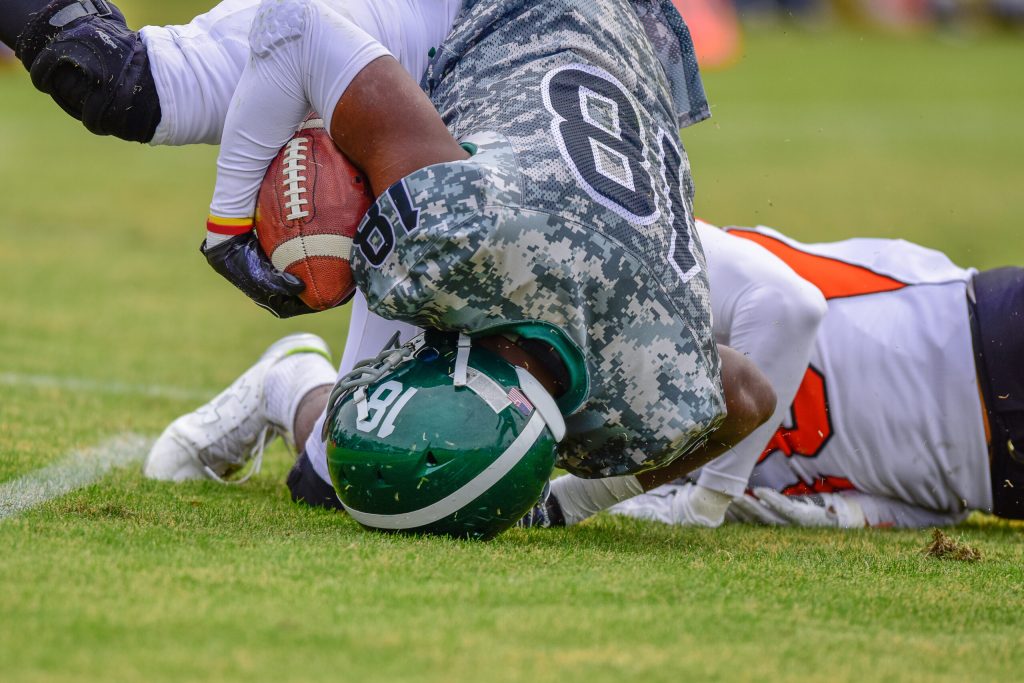Billy watches the sun setting in the distance, shadows beginning to appear along the sideline of the football field. He stands in the backfield at the 24-yard line as the quarterback calls the alignment at the line, getting all the players set. Billy knows the play; it’s a run to the left. He licks his chops and gets ready. Finally, the quarterback huts the ball, and Billy runs up to receive the handoff. He gets the ball and quickly cuts it outside to the left. There is space in front of him with only one player to beat. He gains five yards with lots of space ahead. The linebacker is closing in on him fast. He knows he will have to try and break the tackle if he wants to get more yards. Billy cuts upfield lower his helmet and falls through the linebacker, his helmet contacting the linebacker’s chest pads. Billy breaks the tackle, managing to stay on his feet for a second or two longer, but then tumbles to the ground himself.
After that, Billy didn’t remember anything. He didn’t remember being on the ground for 10 minutes whilst being attended to by trainers. He didn’t remember ending up in the hospital and having a CT scan. That day became a haze in Billy’s mind, and he would never play organized football again. While such a scenario is tragic, it is a possibility for any athlete who plays contact sports. They are putting their bodies and their futures on the line for the sport they love. Athletes, whether they are playing football, hockey, soccer, etc. know that concussions are a risk, as are a wide variety of other injuries. And even if you as an athlete had a sport associated concussion at one point, or currently have a concussion, it does not mean you need to struggle with the symptoms. There are solutions in relieving and/or reducing the symptoms associated with a concussion.
What is a Concussion?
A concussion is a Traumatic Brain Injury (TBI) that results in a temporary loss of normal brain function. Symptoms include amnesia, confusion, nausea, headaches, and other cognitive difficulties. Normally a concussion is caused by a head injury when your head slams into an object or the ground. When a collision with your skull occurs, your brain becomes jostled and can slam around inside your skull. This can result in damage (sometimes permanent) to the brain itself. Such damage leads to lessened functionality of the brain which can mean cognitive, emotional, and physical difficulties. Depending on the severity of the brain injury, symptoms can be mild, with symptoms going away after minutes, or symptoms can be severe and last months or even years after the injury. For athletes who have a history of past concussions or for those athletes who are still experiencing symptoms of a concussion, there is hope.
Concussions in Contact Sports
The National Football League, or NFL, is a contact football league and a multi-million-dollar industry. Every year from September to February, fans grab their beers and their hotdogs and watch the game from the stands, taking in every aspect of the game. The big game, the Superbowl, is one of the most anticipated sporting events each year, with millions of people tuning in from all over the world. They watch the football game, the halftime show, or both. While fans are watching the game, the players down below play the game. Quarterbacks throw footballs for receivers to catch downfield, running backs run with the ball and avoid tacklers, linebackers tackle and make stops, and kickers kick footballs through the uprights. Of course, all this isn’t without its risks. Every snap has a chance to lead to an injury, and as a football player, you are putting your body at risk. One potential injury is a sport-associated concussion. Of course, players aren’t going in unprotected. They wear pads from head to toe and wear sturdy helmets that are enclosed over their skulls. Nonetheless, that does not mean that concussions don’t occur. They do. While helmets do protect the skull from damage, they don’t necessarily protect the brain from getting jolted inside the skull. In the past, players, whether they knew they had a concussion or not, would get right back into the play and play football, even if they were feeling dazed or confused. It was a tough-guy mentality that was part of the game. Players wanted to get right back up and show that they could play and that they were okay. They didn’t want to miss a snap. They didn’t want to portray any weakness. Getting hit was just part of the game.
Nowadays there is more awareness about sport-associated concussions, and NFL players must now go through a concussion protocol to ensure that they don’t have a concussion and are okay to resume playing. Of course, sometimes it can take hours or even days for signs of a sport-associated concussion to materialize so any examination could be moot. If the players are examined, and it is determined that they do have a concussion, they must sit for the remainder of the game. Often, they are right back out there the next week if they are symptom-free. Of course, football isn’t the only sport that has concussion risks. The same can be said about ice hockey, soccer, or basketball. Risks of concussions are there in organized sports and are more likely in contact sports. If you have had, or have a concussion, there are ways in which you can reduce the symptoms of a concussion and improve your brain health.
What Can You Do?
Billy, in the scenario above, experienced a sport-associated concussion, one that would leave him unable to play contact football ever again. If you’ve ever played contact sports, you’ll know that injuries are a part of the game. You could sprain your foot, break your hand, or end up with any number of other potential injuries. The risks are there when you play the game you love. But don’t worry! Dealing with a concussion doesn’t need to be stressful or frustrating. It can get better! There are solutions to healing your brain. If you’ve recently experienced a concussion, the best thing to do is rest. Avoid doing anything that uses your brain. This means avoiding reading, working on the computer, playing video games, or even watching tv. Just rest, sleep, and take it easy. Doing so will allow your brain to heal without exerting it to be used too much. Besides resting, another way to promote the healing of your brain is by focusing on having a healthy nutritional diet. Focus on drinking lots of water, eating foods that are high in natural fat such as avocado, walnuts, and grass-fed butter, and eating lots of vegetables. Simultaneously, avoid drinking caffeinated drinks, and alcohol. Also, avoid any foods that are high in sugar or any that contain saturated fats. For more information on specifics about what to eat as part of your diet, please don’t hesitate to reach out to one of our Nutritional counselors.
Besides nutrition, Neurofeedback therapy is an effective and completely harmless form of brain therapy that can help get you on track. First, QEEG brain mapping technology is used to get an understanding of which areas of the brain have been affected and need support. After that has been determined, Neurofeedback can then be used to target those specific areas through a reward-based system to re-train your brain so that it can heal. Don’t worry! Help is there for you. With the right tools and the right forms of help, you can feel better in no time. If you have any questions or want to know more about how to treat your brain, we encourage you to get in touch with our Elumind client care coordinator. She would be more than happy to chat with you and get you on the right track with receiving the proper care you need.
Elumind Centres for Brain Excellence is an integrated mental health centre offering solutions that can help you with your mental/brain health needs. To start your journey, book your FREE 15-MINUTE PHONE CONSULTATION. We are here for you.








